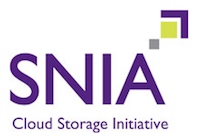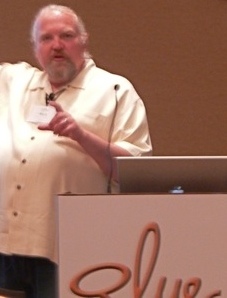 I first met Mark at #CloudCampDenver on the evening before the Glue Conference (the event was also called CloudCamp @ Gluecon). Mark volunteered to head up the breakout group on cloud storage, and he facilitated that quite well. I knew I'd want to interview him before Gluecon was over, with his great background in storage.
I first met Mark at #CloudCampDenver on the evening before the Glue Conference (the event was also called CloudCamp @ Gluecon). Mark volunteered to head up the breakout group on cloud storage, and he facilitated that quite well. I knew I'd want to interview him before Gluecon was over, with his great background in storage.
 I didn't understand till later that he was also Chair of the Cloud Storage Work Group within SNIA. Mark's long career in storage includes 12 years with Sun (recently acquired by Oracle). His title is now Principal Cloud Strategist at Oracle. Follow Mark on Twitter here: @macsun.
I didn't understand till later that he was also Chair of the Cloud Storage Work Group within SNIA. Mark's long career in storage includes 12 years with Sun (recently acquired by Oracle). His title is now Principal Cloud Strategist at Oracle. Follow Mark on Twitter here: @macsun.
Mark is one of the key guys behind SNIA's relatively new Cloud Storage Initiative, the mission of which is stated as "working together toward enabling easier cloud solutions deployment." A big part of this initiative is the new Cloud Data Management Interface (CDMI) Standard, which was the topic of Mark's presentation at the Glue Conference on Thursday afternoon, just prior to my interview with him (link below).
The Cloud Storage Initiative has a full slate of activities planned for 2010, including one that Mark is very much involved in: the 2010 Storage Developers Conference, being held September 20-23 in Santa Clara, CA.
 Now in its seventh year, this event is surely being energized by the seemingly never-ending buzz of "cloud" — which Mark's ultimate boss, Larry Ellison, once called "the orange that's the new pink." (Makes me laugh out loud every time I think of that video clip.) Cloud storage is now being touted by virtually all the traditional storage vendors, and certainly a whole bunch of startups. The SDC event brings together developers, engineers, architects, product/program managers, technical marketing managers, and C-level storage execs as well. I sure hope I have a chance to get there and cover this event. It would be great to live-blog the proceedings, as I did at Glue.
Now in its seventh year, this event is surely being energized by the seemingly never-ending buzz of "cloud" — which Mark's ultimate boss, Larry Ellison, once called "the orange that's the new pink." (Makes me laugh out loud every time I think of that video clip.) Cloud storage is now being touted by virtually all the traditional storage vendors, and certainly a whole bunch of startups. The SDC event brings together developers, engineers, architects, product/program managers, technical marketing managers, and C-level storage execs as well. I sure hope I have a chance to get there and cover this event. It would be great to live-blog the proceedings, as I did at Glue.
To stay connected with what's going with SNIA's cloud storage initiative, here are some key links:
1) Join the Google Group
2) Follow the Twitter account: @SNIAcloud
3) Subscribe to the SNIA Cloud Storage blog
4) Engage with others on Google Buzz

Recent Comments